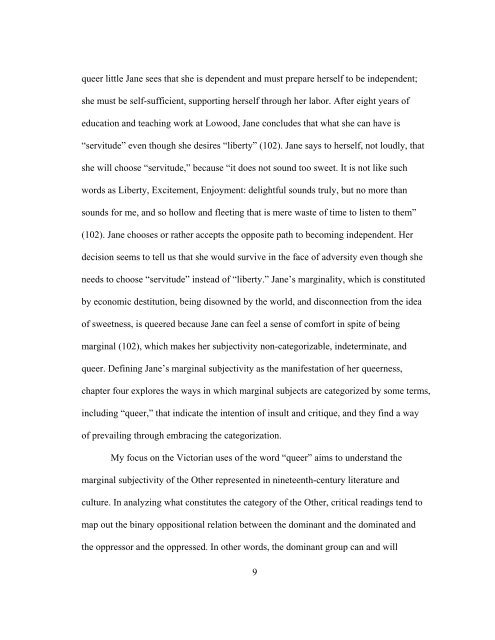CENTURY LITERATURE A Dissertation by JUNG SUN ... - Repository
CENTURY LITERATURE A Dissertation by JUNG SUN ... - Repository
CENTURY LITERATURE A Dissertation by JUNG SUN ... - Repository
Create successful ePaper yourself
Turn your PDF publications into a flip-book with our unique Google optimized e-Paper software.
queer little Jane sees that she is dependent and must prepare herself to be independent;<br />
she must be self-sufficient, supporting herself through her labor. After eight years of<br />
education and teaching work at Lowood, Jane concludes that what she can have is<br />
“servitude” even though she desires “liberty” (102). Jane says to herself, not loudly, that<br />
she will choose “servitude,” because “it does not sound too sweet. It is not like such<br />
words as Liberty, Excitement, Enjoyment: delightful sounds truly, but no more than<br />
sounds for me, and so hollow and fleeting that is mere waste of time to listen to them”<br />
(102). Jane chooses or rather accepts the opposite path to becoming independent. Her<br />
decision seems to tell us that she would survive in the face of adversity even though she<br />
needs to choose “servitude” instead of “liberty.” Jane’s marginality, which is constituted<br />
<strong>by</strong> economic destitution, being disowned <strong>by</strong> the world, and disconnection from the idea<br />
of sweetness, is queered because Jane can feel a sense of comfort in spite of being<br />
marginal (102), which makes her subjectivity non-categorizable, indeterminate, and<br />
queer. Defining Jane’s marginal subjectivity as the manifestation of her queerness,<br />
chapter four explores the ways in which marginal subjects are categorized <strong>by</strong> some terms,<br />
including “queer,” that indicate the intention of insult and critique, and they find a way<br />
of prevailing through embracing the categorization.<br />
My focus on the Victorian uses of the word “queer” aims to understand the<br />
marginal subjectivity of the Other represented in nineteenth-century literature and<br />
culture. In analyzing what constitutes the category of the Other, critical readings tend to<br />
map out the binary oppositional relation between the dominant and the dominated and<br />
the oppressor and the oppressed. In other words, the dominant group can and will<br />
9
















